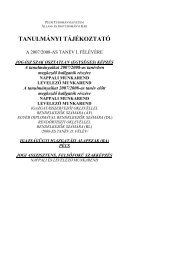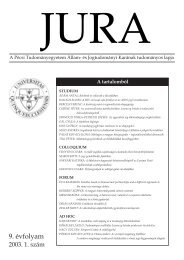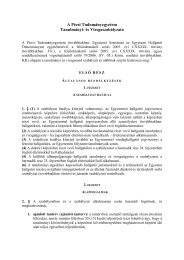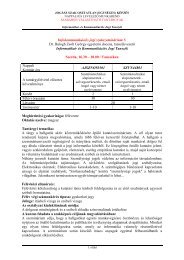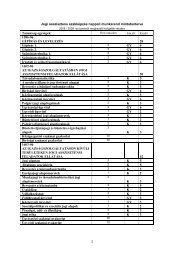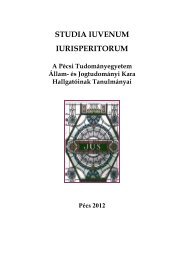2004. évi 2. szám - Jura - Pécsi Tudományegyetem
2004. évi 2. szám - Jura - Pécsi Tudományegyetem
2004. évi 2. szám - Jura - Pécsi Tudományegyetem
Create successful ePaper yourself
Turn your PDF publications into a flip-book with our unique Google optimized e-Paper software.
152<br />
to be a HR expert to draw the conclusion that as a<br />
general rule companies do not send fixed-term employees<br />
to training – they would rather train those<br />
employees whose knowledge can be developed and<br />
used for a long time.<br />
In connection with the implementation of the<br />
fixed-term directive I have dual thoughts and feelings.<br />
In this respect ‘light’ symbolizes the fact that it<br />
is not necessary to choose absolutely between home<br />
and the biological role and career and profession. Accordingly,<br />
a mother with a young child – and, due to<br />
equal opportunities, a father with a young child – has<br />
the opportunity to work and be a mother/father at<br />
the same time. Fixed-term employment is advantageous<br />
for students whose family cannot afford to<br />
fund his/her studies. By providing employment<br />
for students the rules of the directive ensure that<br />
social barriers are breached and that each can fill in<br />
a job in accordance with her/his abilities. However,<br />
next to this light, there is shadow. Take a group of<br />
people employed for a definite period by necessity.<br />
This category of people endeavors to work full time,<br />
but their position is much worse than that of those<br />
who are unemployed. Otherwise, unemployment is<br />
not a legal category; it is a category of employment.<br />
If you, your relatives or friends have ever been in a<br />
situation of unemployment it should be clear to you<br />
that long-term unemployment may cause psychiatric<br />
problems; the feeling of being superfluous and inert<br />
can wreck the personality. The fixed-term directive<br />
regulates the termination of all kind of legal and<br />
administrative obstacles hindering the extension of<br />
fixed-term employment. All of these are fully in line<br />
with the report of the European Employment Working<br />
Group presided over by Wim Kok, the former<br />
Dutch prime minister. The said report was issued<br />
last autumn. Its aim is full employment. In my point<br />
of view this is similar to platonic love – perpetual<br />
struggling which never comes to anything. However,<br />
if we can ensure job possibilities, this struggling is<br />
not useless.<br />
According to Wim Kok’s report, the instrument of<br />
its goal could be the extension of fixed-term employment.<br />
For the success the instruments of labor law are<br />
necessary but not sufficient. The legal environment<br />
is key, but so is the tax-law, and health and pension<br />
insurance. And another absolute economic element,<br />
the wage.<br />
Another legal area is the transfer of undertakings.<br />
This area has a particular resonance in the context of<br />
endeavors to establish the most efficient operational<br />
conditions. The transfers of undertakings require<br />
safeguarding provisions in order to ensure that the<br />
employees’ interests are protected. The newest European<br />
requirements are regulated in Council Directive<br />
István Horváth: Light and shadow<br />
2001/23/EC. Doubtless one positive effect of legal<br />
harmonization, as a consequence of legal succession,<br />
is to be found in the case of transfers of undertakings.<br />
Let me give you an example. If a hospital of a local<br />
government is privatized, the status of the employer<br />
changes and the employees will fall under the scope<br />
of Labor Code as opposed to the scope of the legal<br />
status of public employees.<br />
According to the rules under the former, it was<br />
at the discretion of the privatized hospital whether it<br />
will keep on employing the doctors and nurses formerly<br />
employed as public employees. Following the<br />
harmonization of the directive, this defense lessness<br />
of the employee is over, and now the privatization<br />
of a publicly owned company cannot influence the<br />
existence of employment. This is a good example<br />
which shows that harmonization is important, it does<br />
improve the legal system with respect to guarantees<br />
for employees. The employer transfer directive – with<br />
respect to the rights of employees – leads to another<br />
duality. Just like in national law where we do not<br />
get a full picture if we disregard court practice, in<br />
European law we cannot disregard the practice of<br />
the European Court. In the context of employer<br />
transfers, the practice of the court seated in Luxembourg<br />
is especially important due to globalization,<br />
and internalization of the economy. An American<br />
attorney may also need to know the precedential<br />
court rulings in the same way as his/her European<br />
colleagues do. According to the directive, transfer<br />
means the transfer or merger of the undertaking or<br />
a part thereof to another employer on the basis of a<br />
contract. We can talk about transfer if an economic<br />
unit keeping its identity is being transferred, so it<br />
remains a group of organized assets carrying on<br />
its economic activity. In order to supplement this<br />
I would like to give the essence of a few examples:<br />
According to court practice, the criteria of transfer<br />
is the transfer of material and immaterial assets, the<br />
takeover of personnel, the takeover of clients, the<br />
identity of the activity carried out by the transferor<br />
and the transferee. These criteria have to be examined<br />
as a whole, not one by one. Partly deviating from the<br />
above, the European Court diagnosed transfer in a<br />
case where cleaning services were outsourced in a<br />
bank in respect of one cleaning lady. There was no<br />
transfer of material assets – the court stressed another<br />
criteria, the takeover of personnel, in order to declare<br />
this situation a transfer. The counterexample is a case<br />
from 2002, a case involving a Finnish bus company,<br />
in which the takeover of the workforce was not the<br />
dominant aspect. The winner of the tender on the<br />
operation of the business was provided with the<br />
buses, and through this a material economic asset<br />
was transferred, which gave the court a ground to<br />
deem the transaction as a transfer under the defini-<br />
JURA 2004/<strong>2.</strong>



